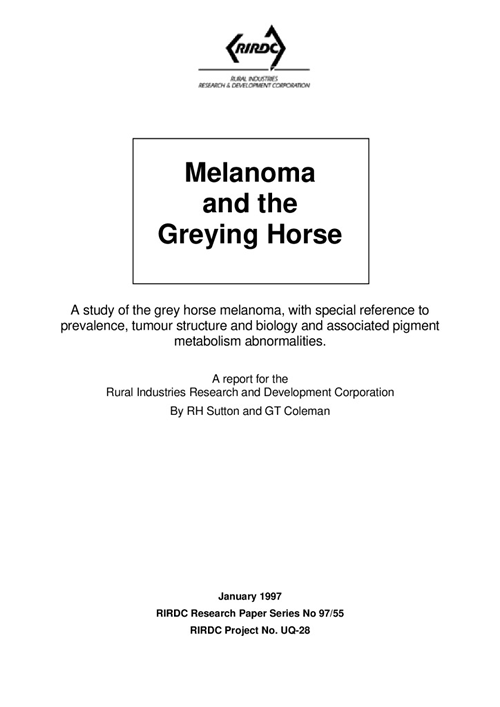Fact sheet: Equine herpes virus
Equine herpes virus (EHV) is a DNA virus found in horses all around the world. There are different strains of EHV, with the most common...
 THOROUGHBRED HORSES
THOROUGHBRED HORSES 
42 pages
Published: 1 Jan 1997
Author(s): Sutton, RH, Cloeman, CT
Download report PDF
DownloadPurchase a hard copy - AUD $45.00
The grey horse melanoma is a widely recognized but poorly understood condition. Its
importance lies in its high prevalence, as a cause of rejection of grey horses for slaughter at
export abattoirs, and as a potential model for pigment cell disorders and malignancies in other
species (including people).
Grey horses can be born any colour but with age there is a dilution of coat colour to grey and then
white. Heavily pigmented tumours develop in many of these animals, apparently concurrent with
the dilution in coat colour. The mechanism which underlies the progressive failure of hair
follicles to produce pigment is unknown.
Although among the most common of equine tumours, the exact nature of the grey horse
melanoma has been the subject of debate since the turn of the century. Some argue that it is
indeed a true malignancy. Other scientists have suggested that it may be a storage disorder
following an abnormality of pigment metabolism; as the hair follicles lose their ability to
produce pigment or pass it on to the growing hair, pigment is stored away in slowly enlarging
masses. Yet another argument is that it is a variant of a type of benign mole seen in people, the
blue naevus. There is evidence to support and undermine each theory but, in truth, we have
progressed little since Lord McFadyean’s description of the condition in 1933.
With recent advances in the study of mammalian pigmentation genetics, there may be new
opportunities to understand the steps leading to the development of this condition. As a requisite
first step, information needs to be gathered on the basic biology of the tumour in grey horses; are
horses with different patterns of coat colour dilution at different levels of risk of contracting the
disease, is there a sex predilection, are other anomalies of pigmentation such as vitiligo involved,
what are the anatomical features of the tumour at both light and electron microscopic levels, and
what ultrastructural changes can be determined in the hair follicles of horses as their coats lose
their colour? These are the questions addressed in the present study.